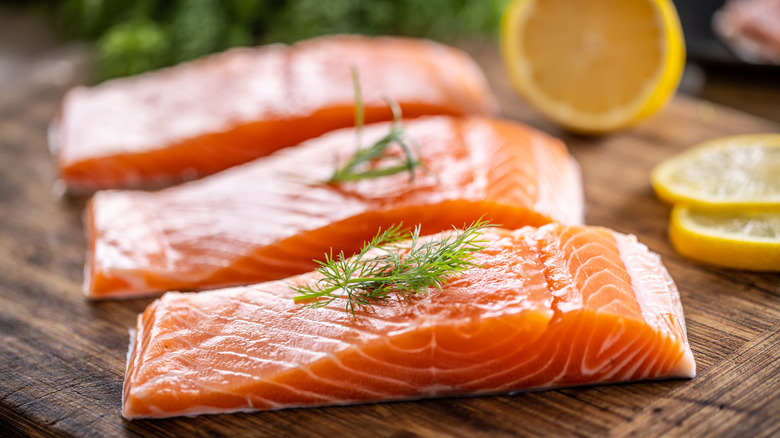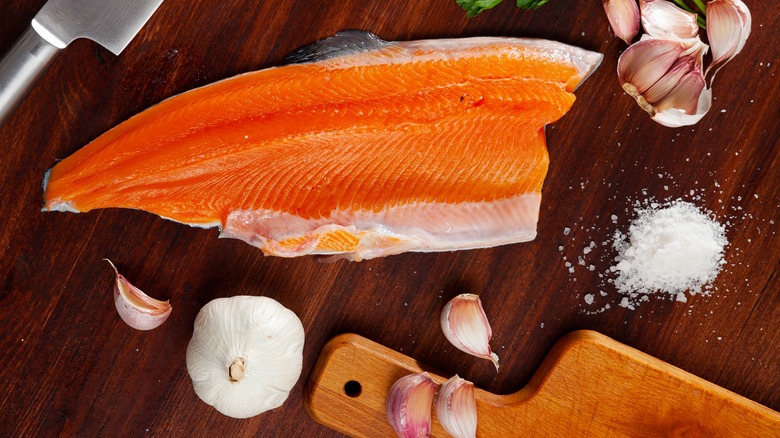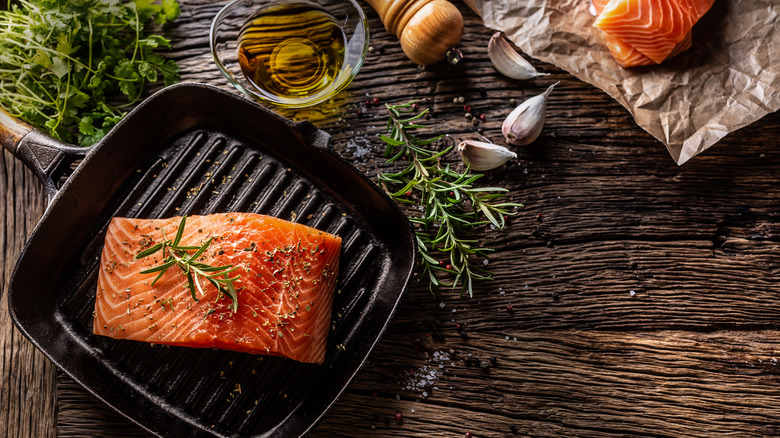Steelhead Trout Vs Salmon: What Are The Differences, Exactly?
Adding more fish to your meal plans can be incredibly intimidating, especially when you start reading the regular reports on the potentially dangerous levels of mercury found in fish as widely available as tuna. When you're buying fish, there's a lot to think about. Are you cooking for someone who's going to abandon fish a few bites in if there's a mushy texture? What about that fishy taste and smell? Is salmon such a go-to that it's tough to convince anyone to try something different?
You may have heard of steelhead trout being touted as a potential alternative to salmon, and it is. They're similar in a lot of ways — including appearance — and that isn't entirely surprising: They both belong to the Salmonidae family. They both spend parts of their lives in fresh- and saltwater environments, and they're both absolutely delicious. There are some key differences that you should be aware of, including taste, availability, the best way to cook each, and price.
Let's talk about those mercury levels first. If that's a concern for you, you should know that generally, steelhead trout has been found to have less mercury than salmon. Speaking of nutritional content, here's another difference: While both are recommended as a source of valuable omega-3 fatty acids and protein, steelhead trout contains about half the amount of fat as salmon. It's not entirely surprising, then, to learn that there are some different ways to get the most out of each type of fish.
Steelhead trout and salmon have different tastes and uses
It's no secret that some of the common complaints that people have about fish is that distinctly fishy taste. If that's keeping you from regularly eating fish, try steelhead trout (pictured). While salmon is often described as having a more fish-forward flavor, steelhead is known for being sweeter and a better option for someone who's looking for a fish that doesn't have that love-or-hate strong, fishy flavor. Steelhead trout is generally better when paired with more delicate flavors, spices, and sauces, and there are some things to keep in mind when cooking one or the other.
Steelhead's mild flavor might mean you'll need more seasonings and spices for a fully-flavored meal, and the differences in the nutritional content of these two types of fish means that they're going to cook differently. Because steelhead tends to be lower in fat and oil content, it's easy to end up with a dry piece of fish. Salmon is much more beginner-friendly and less likely to dry out, which means it's much easier to work with if you're looking for a fish to grill.
In order to prepare steelhead in a way that's more likely to leave you with a moist, buttery piece of fish, consider poaching it instead of grilling or frying. It also works really well in delicate baked dishes: think of something like an herbed steelhead trout with fried carrots. Baking — after marinating with vegetable cubes and butter — will help preserve the integrity of the fish.
Steelhead trout is more affordable and available year-around
There's nothing that's more disappointing than heading to the grocery store with a specific meal in mind, only to find you can't find some of the ingredients you need. Steelhead trout has a major advantage here, because while most species of salmon (pictured) — both wild-caught and farmed — are in season during specific months, steelhead trout will be available all year round.
There's a lot of oft-repeated misconceptions about farm-raised fish, but when done responsibly, it can be an environmentally-friendly, sustainable method of food production. Since steelhead trout is more commonly farm-raised than salmon, that means it's not only more widely available everywhere from fishmongers to grocery stores, but it's more affordable.
That said, there's still some debate if farm-raised or wild-caught is better. It's a complicated issue, but here's the bottom line when it comes to steelhead trout and salmon: Both are touted as a nutritious fish that's high in protein and omega-3 fatty acids, which means they're both popular options for serving up more fish. Which you and your family prefer might come down to preferences in taste and preparation, but knowing the differences will help you choose something everyone will enjoy.


